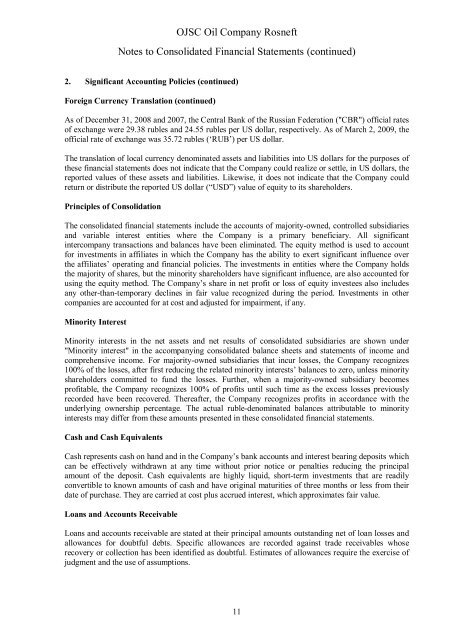OJSC Oil Company Rosneft Consolidated Financial Statements
OJSC Oil Company Rosneft Consolidated Financial Statements
OJSC Oil Company Rosneft Consolidated Financial Statements
Create successful ePaper yourself
Turn your PDF publications into a flip-book with our unique Google optimized e-Paper software.
<strong>OJSC</strong> <strong>Oil</strong> <strong>Company</strong> <strong>Rosneft</strong><br />
Notes to <strong>Consolidated</strong> <strong>Financial</strong> <strong>Statements</strong> (continued)<br />
2. Significant Accounting Policies (continued)<br />
Foreign Currency Translation (continued)<br />
As of December 31, 2008 and 2007, the Central Bank of the Russian Federation ("CBR") official rates<br />
of exchange were 29.38 rubles and 24.55 rubles per US dollar, respectively. As of March 2, 2009, the<br />
official rate of exchange was 35.72 rubles (‘RUB’) per US dollar.<br />
The translation of local currency denominated assets and liabilities into US dollars for the purposes of<br />
these financial statements does not indicate that the <strong>Company</strong> could realize or settle, in US dollars, the<br />
reported values of these assets and liabilities. Likewise, it does not indicate that the <strong>Company</strong> could<br />
return or distribute the reported US dollar (“USD”) value of equity to its shareholders.<br />
Principles of Consolidation<br />
The consolidated financial statements include the accounts of majority-owned, controlled subsidiaries<br />
and variable interest entities where the <strong>Company</strong> is a primary beneficiary. All significant<br />
intercompany transactions and balances have been eliminated. The equity method is used to account<br />
for investments in affiliates in which the <strong>Company</strong> has the ability to exert significant influence over<br />
the affiliates’ operating and financial policies. The investments in entities where the <strong>Company</strong> holds<br />
the majority of shares, but the minority shareholders have significant influence, are also accounted for<br />
using the equity method. The <strong>Company</strong>’s share in net profit or loss of equity investees also includes<br />
any other-than-temporary declines in fair value recognized during the period. Investments in other<br />
companies are accounted for at cost and adjusted for impairment, if any.<br />
Minority Interest<br />
Minority interests in the net assets and net results of consolidated subsidiaries are shown under<br />
"Minority interest" in the accompanying consolidated balance sheets and statements of income and<br />
comprehensive income. For majority-owned subsidiaries that incur losses, the <strong>Company</strong> recognizes<br />
100% of the losses, after first reducing the related minority interests’ balances to zero, unless minority<br />
shareholders committed to fund the losses. Further, when a majority-owned subsidiary becomes<br />
profitable, the <strong>Company</strong> recognizes 100% of profits until such time as the excess losses previously<br />
recorded have been recovered. Thereafter, the <strong>Company</strong> recognizes profits in accordance with the<br />
underlying ownership percentage. The actual ruble-denominated balances attributable to minority<br />
interests may differ from these amounts presented in these consolidated financial statements.<br />
Cash and Cash Equivalents<br />
Cash represents cash on hand and in the <strong>Company</strong>’s bank accounts and interest bearing deposits which<br />
can be effectively withdrawn at any time without prior notice or penalties reducing the principal<br />
amount of the deposit. Cash equivalents are highly liquid, short-term investments that are readily<br />
convertible to known amounts of cash and have original maturities of three months or less from their<br />
date of purchase. They are carried at cost plus accrued interest, which approximates fair value.<br />
Loans and Accounts Receivable<br />
Loans and accounts receivable are stated at their principal amounts outstanding net of loan losses and<br />
allowances for doubtful debts. Specific allowances are recorded against trade receivables whose<br />
recovery or collection has been identified as doubtful. Estimates of allowances require the exercise of<br />
judgment and the use of assumptions.<br />
11








